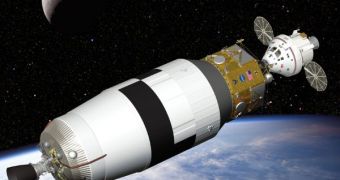The spaceflight review committee appointed by President Barack Obama early on this year revealed two days ago its first official report summary, detailing possible future avenues of development for the American space agency. Five basic options are detailed in the 12-page document, of which only two are closely related to the ongoing Project Constellation, Space reports. The full assessment is scheduled to be released near the end of this month.
Among the most important highlights of the document is the fact that four of the options state that the retirement of the space shuttles should be delayed until at least mid-2011, as opposed to the 2010 deadline currently in effect. The fifth option argues that the shuttles should be retired only in 2015, when, at least in theory, the Project is supposed to come online.
One of the options in the new report states that NASA should continue its current plans, but argues that the Orion Crew Exploration Vehicle and the ARES I rocket would not become available until 2016. For the heavy-lift member of the Project, ARES V, the deadline for completion would move in the late 2020s, the same report also shows, while the Altair Lunar Lander would only be completed in the 2030s, if ever. This option relies on the fact that the agency's budget will not be increased over the next five years, its authors show.
Another related possibility is to start working on a smaller version of the ARES V, and to stop work on the Altair module, and other equipment destined solely for the Moon. The US participation in the International Space Station would conclude in 2020 instead of 2015, and the main focus would be set on developing cost-effective ways of delivering astronauts to and from low-Earth orbit.
All the remaining three options deal with a scenario in which the space agency's budget increases steadily over the next five years, by an estimated $3 billion, more than the current plans until 2014. Under this plan, the revenues would also be augmented by an amount that would keep up with the rate of inflation each year afterwards, or about a 2.4-percent increase.
There are also some voices within the panel who argue that the burden on manned spaceflight to low Earth orbit should be given to the private sector, which would essentially allow NASA to focus on broader goals, such as exploring the Moon, Mars, the Lagrangian orbit points, the nearby asteroids and other points of interest. Under this plan, a return to the Moon would be scheduled for the late 2020s. More details will become available once the full report is released.

 14 DAY TRIAL //
14 DAY TRIAL //